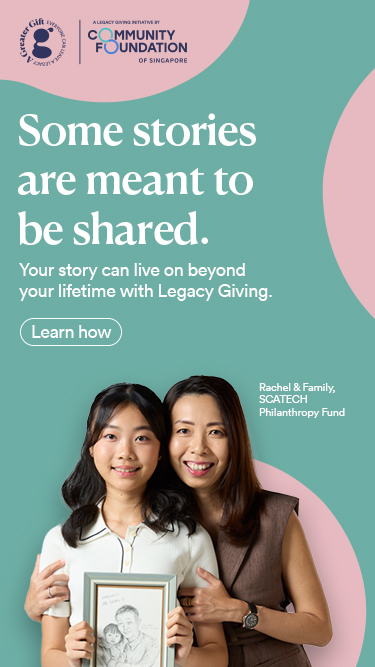Lianhe Zaobao: More companies and individuals seeking professionals to manage their charitable funds


新加坡社区基金会成立10年来,设立或管理的慈善基金从2008年的两 个增至今年2月的110个,而基金会筹获的善款也已达1亿元,发放的 款项达6000万元,惠及的慈善团体多达400个。
Song Huichun
随着国人对有效行善的意识提高,更多企业和个人善款捐赠者过 去10年来选择与专人合作,协助他们管理和发放善款给希望帮助的机 构或项目。
数据显示,捐赠者透过新加坡社区基金会(Community Foundation of Singapore)设立或管理的慈善基金从2008年的两个 增至2013年3月的47个,到了今年2月已增至110个,10年来增幅超过50 倍。
协助企业或个人捐赠者以可持续、妥善和具透明度的方式管理与 设立行善基金的新加坡社区基金会迈入第10年,多年来,基金会把捐 赠者与他们关注的相关慈善团体妥善配对,制定有效行善策略,让更 多有需要者受惠。
基金会总裁罗佩仪(50岁)接受《联合早报》访问并透露上述数 据时说,基金会成立之初希望做的是通过了解捐赠者关注的课题及行 善动力,协助发展出一套适合捐赠者的有效行善策略。
新加坡社区基金会在本地超过2000个慈善机构中找出适合捐赠 者资助的项目……找出不同群体的需求及捐赠者可提供协助的机会, 让捐赠者可更有效地施予援助,发挥更大影响力。”
罗佩仪说,在为捐赠者与慈善项目或机构进行配对时,捐赠者的 理念、兴趣、愿意承担风险的限度、拨款数额等都会影响基金会所做 的推荐。而基金会发挥的影响力,也随着更多国人了解以有效方式行 善何其重要后,逐年增加。
深入了解慈善机构运作 及善款影响力
基金会提供给本报的数据显示,截至2013年3月,基金会共筹到 5000万元善款,发放的款项约1200万元,惠及130个慈善伙伴。
而到了今年2月,基金会筹获的善款已达1亿元,发放的款项达 6000万元,惠及的慈善团体多达400个。
为了确保善款获得妥善运用,基金会也会深入了解慈善机构的运 作、领导班子、受惠人如何获益、财务状况、个别项目如何进行、有 多少资源、有没有执行能力等。基金会也会为捐赠者跟进汇报善款发 挥的影响力,以及使用后的结果等。
罗佩仪说:“企业一般上会觉得这样的模式很管用,因为他们必 须向股东汇报善款用途。”
她也说,基金会未来会继续透过讲座和活动接触更多群体,让各 方更了解基金会提供的服务。
运输业者发挥“专长” 让派发食物更有效
交通运输企业行善不忘发挥专业,出钱出力出车,协助非盈利组织有效地派发更多食物给有需要的人。
交通运输业者金钟集团(Goldbell Group)自2015年起成立金钟基金会,探讨如何在经营生意的同时尽社会企业责任,选择帮助真正需要帮助的人。
金钟财务服务私人有限公司执行董事蔡满榜(38岁)积极带领金钟集团履行企业社会责任,他受访时说,在和新加坡社区基金会合作行善之前,金钟集团一般都以零星方式回馈社会,有机会就帮忙,没有一个制式的行善结构。
在金钟基金会成立隔年,因刚好有一名新加坡社区基金会成员认识蔡满榜的父亲,从此,金钟集团就透过新加坡社区基金会从旁牵线和指引,确认行善计划和目的,帮助本身关注的群体。
金钟基金会和新加坡社区基金会展开合作初期,计划每年拨出30万元行善,而慈善团体“爱心食品”(Food From The Heart)是金钟基金会资助的团体之一。
蔡满榜说:“与该团体数次接触后,发现我个人的行善理念与他们的管理营运理念不谋而合,尤其是他们去找合作伙伴捐赠食品给他们要帮助的人,而不是花钱购买食品。”
在透过新加坡社区基金会促成更有效的合作之前,金钟集团已免费租借两辆有冷冻设备的卡车给“爱心食品”,方便他们载送易腐食品。
现在,金钟集团允诺资助“爱心食品”三年,支持该组织卡车队的营运和载送食品给有需要者所需的营运费用等。
如此一来,“爱心食品”就能更好地进行预算和营运规划,确保在金钟集团资助期间,有需者可持续获得食品援助。
除了“爱心食品”,金钟集团也资助过不少个别项目,包括绿色生活、援助有需要青年等。
Link to story: Here.
Translation:
More companies and individuals seeking professionals to manage their charitable funds
In the 10 years since the Community Foundation of Singapore was established, the number of charitable funds set up or managed has increased from two in 2008 to 110 in February this year. The donations raised by the foundation have also reached $100 million, with $60 million distributed, benefiting up to 400 charities.
Song Huichun
As awareness of effective charitable giving increases, more corporate and individual donors have spent the past 10 years choosing to collaborate with dedicated professionals to help them manage and distribute charitable funds to the institutions or projects they wish to help.
According to statistics, charitable funds created or managed by donors through the Community Foundation of Singapore increased from two in 2008 to 47 in March 2013 and further increased to 110 in February this year. In 10 years, it has gone up more than 50 folds.
The Community Foundation of Singapore, which assists corporate or individual donors to manage and establish charitable funds in a sustainable, appropriate and transparent manner, is reaching its 10th year. Over the years, the Foundation has properly matched donors with the charities they care about, formulating effective strategies for good practices to benefit more people in need.
When CFS CEO Catherine Loh, 50, accepted the Zaobao interview, she disclosed the data above and added that the Foundation’s initial hope was to help develop a set of donor-friendly products by understanding donors’ concerns and the motivation to do good.
The Community Foundation of Singapore has identified programmes that are suitable for support from more than 2,000 charitable organisations in the country by identifying the needs of different groups to provide opportunities for assistance so that donors can more effectively provide assistance and make greater impact.
Ms Loh said that when pairing donors with charitable projects or institutions, the donor’s ideas, interests, willingness to take risks, the amount of funding, etc. all influence the Foundation’s recommendations. The influence of the Foundation is also gradually increasing as more people understand how important it is to be effective.
Learning more about charity operations and the impact of charitable funds
According to the data provided by the Foundation, as of March 2013, it had raised a total of $50 million in donations, with $12 million grants given out, benefiting 130 charitable partners.
In February this year, the donations raised by the Foundation reached $100 million, with grants amounting to $60 million, benefiting up to 400 charities.
In order to ensure the proper use of donations, the Foundation has an in-depth understanding of charity operations, leadership, impact on beneficiaries, financial status, how individual projects are run, how much resources they have, and whether they have executive capabilities. The Foundation also follow up with donors to report on the impact of charitable donations, as well as the outcomes.
Ms Loh said: “Companies generally feel that this model is very useful, because they must report to shareholders on the use of funds.”
She also said that in the future, the Foundation will continue to reach out to more groups through lectures and events so that all parties can better understand the services provided by the Foundation.
Transport operators use their expertise to make food delivery more effective
Transportation companies have not forgotten their professional role – using their expertise and money to help non-profit organisations to effectively distribute food to those in need.
Transportation company Goldbell Group established the Goldbell Foundation in 2015 to explore how to conduct social responsibility while running their business and helping those in need.
Alex Chua, 38, Executive Director of Goldbell Financial Services Pte Ltd, actively led the Goldbell Group in fulfilling its corporate social responsibilities. During the interview, he said that prior to collaborating with the Community Foundation of Singapore, the Goldbell Group generally gave back to society in sporadic ways. If there’s an opportunity, they help, there was no structure for doing good.
In the year after the Goldbell Foundation was established, a member of the Community Foundation of Singapore who knew his father William Chua reached out to them. Since then, through guidance provided by the Community Foundation of Singapore, they have a philanthropic plan and goals, helping causes of their choice.
In the early stages of the collaboration between Goldbell Foundation and the Community Foundation of Singapore, it plans to set aside $300,000 a year to support charities, and charity Food from the Heart is one of the groups funded by the Goldbell Foundation.
Mr Chua said: “After several interactions with the organisation, I discovered that my concept of personal goodwill is in line with their management concept. In particular, they approach partners to donate food to the people they want to help, rather than spend money to buy food.”
Prior to promoting more effective collaboration through the Community Foundation of Singapore, the Goldbell Group has already rented two trucks with freezer equipment to Food from the Heart to facilitate the delivery of perishable foods.
Now Goldbell Group has promised to fund Food from the Heart for three years to support the operation of the truck fleet as well as the operating expenses required to transport food to beneficiaries.
As a result, Food from the Heart is able to better budget and plan its operations to ensure that those in need can continue to receive food assistance during the period the Goldbell Group is funding.
In addition to supporting Food from the Heart, Goldbell Group has also funded a number of individual projects, including environment projects, and providing help to young people.
Photo: Lianhe Zaobao
新加坡社区基金会成立10年来,设立或管理的慈善基金从2008年的两 个增至今年2月的110个,而基金会筹获的善款也已达1亿元,发放的 款项达6000万元,惠及的慈善团体多达400个。
Song Huichun
随着国人对有效行善的意识提高,更多企业和个人善款捐赠者过 去10年来选择与专人合作,协助他们管理和发放善款给希望帮助的机 构或项目。
数据显示,捐赠者透过新加坡社区基金会(Community Foundation of Singapore)设立或管理的慈善基金从2008年的两个 增至2013年3月的47个,到了今年2月已增至110个,10年来增幅超过50 倍。
协助企业或个人捐赠者以可持续、妥善和具透明度的方式管理与 设立行善基金的新加坡社区基金会迈入第10年,多年来,基金会把捐 赠者与他们关注的相关慈善团体妥善配对,制定有效行善策略,让更 多有需要者受惠。
基金会总裁罗佩仪(50岁)接受《联合早报》访问并透露上述数 据时说,基金会成立之初希望做的是通过了解捐赠者关注的课题及行 善动力,协助发展出一套适合捐赠者的有效行善策略。
新加坡社区基金会在本地超过2000个慈善机构中找出适合捐赠 者资助的项目……找出不同群体的需求及捐赠者可提供协助的机会, 让捐赠者可更有效地施予援助,发挥更大影响力。”
罗佩仪说,在为捐赠者与慈善项目或机构进行配对时,捐赠者的 理念、兴趣、愿意承担风险的限度、拨款数额等都会影响基金会所做 的推荐。而基金会发挥的影响力,也随着更多国人了解以有效方式行 善何其重要后,逐年增加。
深入了解慈善机构运作 及善款影响力
基金会提供给本报的数据显示,截至2013年3月,基金会共筹到 5000万元善款,发放的款项约1200万元,惠及130个慈善伙伴。
而到了今年2月,基金会筹获的善款已达1亿元,发放的款项达 6000万元,惠及的慈善团体多达400个。
为了确保善款获得妥善运用,基金会也会深入了解慈善机构的运 作、领导班子、受惠人如何获益、财务状况、个别项目如何进行、有 多少资源、有没有执行能力等。基金会也会为捐赠者跟进汇报善款发 挥的影响力,以及使用后的结果等。
罗佩仪说:“企业一般上会觉得这样的模式很管用,因为他们必 须向股东汇报善款用途。”
她也说,基金会未来会继续透过讲座和活动接触更多群体,让各 方更了解基金会提供的服务。
运输业者发挥“专长” 让派发食物更有效
交通运输企业行善不忘发挥专业,出钱出力出车,协助非盈利组织有效地派发更多食物给有需要的人。
交通运输业者金钟集团(Goldbell Group)自2015年起成立金钟基金会,探讨如何在经营生意的同时尽社会企业责任,选择帮助真正需要帮助的人。
金钟财务服务私人有限公司执行董事蔡满榜(38岁)积极带领金钟集团履行企业社会责任,他受访时说,在和新加坡社区基金会合作行善之前,金钟集团一般都以零星方式回馈社会,有机会就帮忙,没有一个制式的行善结构。
在金钟基金会成立隔年,因刚好有一名新加坡社区基金会成员认识蔡满榜的父亲,从此,金钟集团就透过新加坡社区基金会从旁牵线和指引,确认行善计划和目的,帮助本身关注的群体。
金钟基金会和新加坡社区基金会展开合作初期,计划每年拨出30万元行善,而慈善团体“爱心食品”(Food From The Heart)是金钟基金会资助的团体之一。
蔡满榜说:“与该团体数次接触后,发现我个人的行善理念与他们的管理营运理念不谋而合,尤其是他们去找合作伙伴捐赠食品给他们要帮助的人,而不是花钱购买食品。”
在透过新加坡社区基金会促成更有效的合作之前,金钟集团已免费租借两辆有冷冻设备的卡车给“爱心食品”,方便他们载送易腐食品。
现在,金钟集团允诺资助“爱心食品”三年,支持该组织卡车队的营运和载送食品给有需要者所需的营运费用等。
如此一来,“爱心食品”就能更好地进行预算和营运规划,确保在金钟集团资助期间,有需者可持续获得食品援助。
除了“爱心食品”,金钟集团也资助过不少个别项目,包括绿色生活、援助有需要青年等。
Link to story: Here.
Translation:
More companies and individuals seeking professionals to manage their charitable funds
In the 10 years since the Community Foundation of Singapore was established, the number of charitable funds set up or managed has increased from two in 2008 to 110 in February this year. The donations raised by the foundation have also reached $100 million, with $60 million distributed, benefiting up to 400 charities.
Song Huichun
As awareness of effective charitable giving increases, more corporate and individual donors have spent the past 10 years choosing to collaborate with dedicated professionals to help them manage and distribute charitable funds to the institutions or projects they wish to help.
According to statistics, charitable funds created or managed by donors through the Community Foundation of Singapore increased from two in 2008 to 47 in March 2013 and further increased to 110 in February this year. In 10 years, it has gone up more than 50 folds.
The Community Foundation of Singapore, which assists corporate or individual donors to manage and establish charitable funds in a sustainable, appropriate and transparent manner, is reaching its 10th year. Over the years, the Foundation has properly matched donors with the charities they care about, formulating effective strategies for good practices to benefit more people in need.
When CFS CEO Catherine Loh, 50, accepted the Zaobao interview, she disclosed the data above and added that the Foundation’s initial hope was to help develop a set of donor-friendly products by understanding donors’ concerns and the motivation to do good.
The Community Foundation of Singapore has identified programmes that are suitable for support from more than 2,000 charitable organisations in the country by identifying the needs of different groups to provide opportunities for assistance so that donors can more effectively provide assistance and make greater impact.
Ms Loh said that when pairing donors with charitable projects or institutions, the donor’s ideas, interests, willingness to take risks, the amount of funding, etc. all influence the Foundation’s recommendations. The influence of the Foundation is also gradually increasing as more people understand how important it is to be effective.
Learning more about charity operations and the impact of charitable funds
According to the data provided by the Foundation, as of March 2013, it had raised a total of $50 million in donations, with $12 million grants given out, benefiting 130 charitable partners.
In February this year, the donations raised by the Foundation reached $100 million, with grants amounting to $60 million, benefiting up to 400 charities.
In order to ensure the proper use of donations, the Foundation has an in-depth understanding of charity operations, leadership, impact on beneficiaries, financial status, how individual projects are run, how much resources they have, and whether they have executive capabilities. The Foundation also follow up with donors to report on the impact of charitable donations, as well as the outcomes.
Ms Loh said: “Companies generally feel that this model is very useful, because they must report to shareholders on the use of funds.”
She also said that in the future, the Foundation will continue to reach out to more groups through lectures and events so that all parties can better understand the services provided by the Foundation.
Transport operators use their expertise to make food delivery more effective
Transportation companies have not forgotten their professional role – using their expertise and money to help non-profit organisations to effectively distribute food to those in need.
Transportation company Goldbell Group established the Goldbell Foundation in 2015 to explore how to conduct social responsibility while running their business and helping those in need.
Alex Chua, 38, Executive Director of Goldbell Financial Services Pte Ltd, actively led the Goldbell Group in fulfilling its corporate social responsibilities. During the interview, he said that prior to collaborating with the Community Foundation of Singapore, the Goldbell Group generally gave back to society in sporadic ways. If there’s an opportunity, they help, there was no structure for doing good.
In the year after the Goldbell Foundation was established, a member of the Community Foundation of Singapore who knew his father William Chua reached out to them. Since then, through guidance provided by the Community Foundation of Singapore, they have a philanthropic plan and goals, helping causes of their choice.
In the early stages of the collaboration between Goldbell Foundation and the Community Foundation of Singapore, it plans to set aside $300,000 a year to support charities, and charity Food from the Heart is one of the groups funded by the Goldbell Foundation.
Mr Chua said: “After several interactions with the organisation, I discovered that my concept of personal goodwill is in line with their management concept. In particular, they approach partners to donate food to the people they want to help, rather than spend money to buy food.”
Prior to promoting more effective collaboration through the Community Foundation of Singapore, the Goldbell Group has already rented two trucks with freezer equipment to Food from the Heart to facilitate the delivery of perishable foods.
Now Goldbell Group has promised to fund Food from the Heart for three years to support the operation of the truck fleet as well as the operating expenses required to transport food to beneficiaries.
As a result, Food from the Heart is able to better budget and plan its operations to ensure that those in need can continue to receive food assistance during the period the Goldbell Group is funding.
In addition to supporting Food from the Heart, Goldbell Group has also funded a number of individual projects, including environment projects, and providing help to young people.
Photo: Lianhe Zaobao
- Related Topics For You: CHARITY STORIES, CLIMATE & ENVIRONMENT, DONOR STORIES, DONOR-ADVISED FUND, ENVIRONMENT, INCLUSIVITY & INTEGRATION, NEWS, STORIES OF IMPACT, YOUTH



